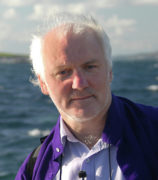What a month November is. Already, and we’re only five days into it, we’ve had Hallowmas and All Saints Day and All Souls Day and the presidential election and Guy Fawkes, not to mention Armistice Day coming up next week, on Martinmas, and the on-going Covid and climate crises.
In a world of 24-hours-a-day mass media we still have much to keep us rooted: our own traditions articulate a worldview as much as the news from the other end of the global village.
I’m not sure we ever had Halloween growing up. The modern trick-or-treat version had not yet been imported. We had Oidhche Shamhna, which took place on Halloween night, which was more or less the same thing, except we didn’t have apples (I think the marauding Vikings and King James’s need for wooden-ships, and then the post-Clearances sheep, had devoured all the trees by then) so it was the alternative of taking Archie’s cart in the twilight and moving it along the road a mile or so and – the big boys dared do this – putting turfs on the little windows of Ewan’s cottage so he’d think it was still the middle of the night when he woke up in the morning, and sleep on till afternoon. He never did, for despite all our efforts, there he was on the 1st of November standing quietly at his door as usual in the early morning light, puffing away at his clay pipe.
But whether Samhain in the Gaelic world or guising in Scots or Nut-crack night in England or a feast of stwmo naw rhyw (a mash of nine different root vegetables with milk butter, salt and pepper) in Wales, the beginning of our modern November has always been marked as a kind of twilight zone, signalling the end of growth and the beginning of dormancy.
Not that these things were fixed. In my childhood, naming the months in the ‘modern fashion’ (January, February etc) was a relatively new phenomenon, with older people in the middle district of my native South Uist recorded in my childhood (by the folklorist K. C. Craig) using the old quarterly dispensations: they began the year in what is now our February, naming it ‘Ciad mìos an Earraich’ (‘The first month of the Spring’), with March called ‘the middle month of the Spring,’ and April ‘the last month of the Spring’. May was ‘Ciad mìos an t-Samhraidh’ (‘The first month of the Summer’) and so on… though another proverb puts winter further back – ‘Cha tig geamhradh gu cùl Calluin, no Earrach gu Fèill Pàdraig’ – ‘Winter comes not until after Hogmanay, nor Springtime until after St Patrick’s Day (17th March).
The transformation from autumn to winter was always a liminal time, where the borders between light and dark, growth and decay, this world and the next, became fluid. Think of the flowers and crops springing forth from the earth in early spring and then bursting into full bloom all summer long into the great harvest time, and then all that energy – all that life – dying away and the ground becoming cold and bare and barren.
You had to mark that, not as a separation (as a death) but as a continuation (as life). That’s why the Christian twin festivals of All Saints’ Day (1st November) and All Souls’ Day (2nd November) are so important: they gave folk an institutional means to remember and (despite the Reformation) to pray for the dead, magnifying them all as one eternal community.
In common lore, of course, it was the night when ghouls and witches and all things uncommon were abroad. It gave young people, in particular, permission to liberate themselves from the daily grind of social norms. As ever, Robert Burns captured the spirit of the time well, simply because he was so well acquainted with it: “Upon that night, when fairies light/ On Cassilis Downans dance/Or owre the lays, in splendid blaze/ On sprightly coursers prance;/ Or for Colean the route is ta’en/ Beneath the moon’s pale beams/There, up the cove, to stray and rove/Among the rocks and streams/To sport that night.”
As ever with Burns, it was a grand night not just for the fairies and warlocks but for the lads and lassies. His long splendid poem tells of magic ways of discovering who your love will be; of divining the future through the way natural things like hemp-seed or blue yarn or an apple peel fell into shape. A bit like the presidential election really.
Angus Peter Campbell is an award-winning writer and actor from South Uist

